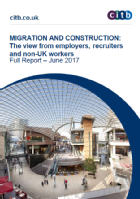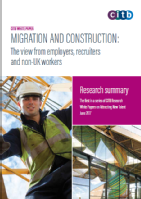Research into Migration in the UK Construction and Built Environment Sector
This project, conducted on behalf of the Construction Industry Training Board (CITB) explores the use of non-UK origin workers in the UK Construction and Built Environment sector. The project is intended to provide CITB with evidence to inform CITB’s approach to helping construction firms train a sufficient supply of skilled workers. The lead contractor is the survey company IFF Research, which is also responsible for the survey work.
The project has the following objectives:
- to assess the scale of migrant labour in the UK construction industry including patterns of employment by region and occupation;
- to describe the demographics of migrant labour in terms of age, sex, marital status, family size, country of origin, occupations, prior qualifications, licenses to practice, and employment status in terms of direct employment, employment by recruitment agencies/intermediaries and self-employment including income;
- to determine future plans of migrant labour;
- to describe the characteristics of employers by sector and size who recruit migrant labour and to assess the role of recruitment agencies domestically and overseas;
- to identify the benefits of migrant labour to construction employers and the industry as a whole and flexibility offered by recruitment agencies;
- to describe current EU/non-EU immigration policy and its operation in relation to the construction industry;
- to describe options for controlling EU immigration under consideration by the UK government and assess their impact on the ability of the construction industry to deliver construction projects;
- to assess the response of construction employers and the industry more widely to tighter restrictions on recruiting EU migrant workers and;
- to identify opportunities presented to CITB as strategic body in the context of a tighter immigration policy by April 2019.
The project has two broad elements:
- Policy analysis/statistics review (undertaken by the IER)
- Market research/consultation with employers/labour agencies/non-UK origin workers and other stakeholders from the Construction and Built Environment sector (undertaken by IFF Research).
Phase 1 – Policy Analysis/Review
Strand 1: Review of Current Immigration Policy
A review of existing immigration policy with respect to EU and non-EU workers including the identification of countries which currently supply workers to the UK construction industry.
Strand 2: Review of Official Migration Statistics and Benefits of Migrant Workers
A thorough review of official statistics and publications on the scale of migrant labour in the UK construction industry, will identify information beyond what has been published by the Migration Advisory Committee and labour market statistics published by the ONS. It will identify and summarise academic studies assessing the benefits of EU/non-EU migration to the construction industry.
Strand 3: Review of Future EU-Migrant Worker Policy
This element of the research will produce a paper summarising the options for controlling EU-migrant workers based on the latest information on the UK Government and EU positions, and presenting a range of options for control of migrant workers.
Phase 2 – Qualitative Interviews
Strand 4: Employer Interviews
Around 20 face-to-face interviews with employers – direct contractors, tier 2 contractors and sub-contractors - in order to obtain an indication of their use of migrant labour as well as their use of migrant labour employed by employment agencies.
Strand 5: Employment Agency Interviews
Face-to-face interviews (5) will be conducted with employment agencies in order to identify the scale of their operations in the construction industry, the pay and conditions of their staff and the benefits to the construction industry as they perceive them of EU migrant labour.
Strand 6: Non-UK origin worker interviews
There will be 10 face-to-face interviews with non-EU migrant workers – to seek views on their experience of working in the UK construction industry. Interviewees will include a mixture of those working in low skilled, skilled trades and professional occupations.
Strand 7: CITB Interviews
Up to 5 face-to-face interviews will be conducted with CITB decision makers across Great Britain. The purpose is to gather initial thoughts on the opportunities for CITB as a strategic body promoting a ‘grow-your-own skills’ strategy, and assess implications for the apprenticeship levy, CITB levy and wider skills and employment policies.
Phase 3 – Quantitative Surveys
Strand 8: Employer Survey
This involves a quantitative survey of 401 employers, encompassing direct contractors, tier two contractors and sub-contractors in order to establish baseline estimates of the proportion of construction employers by size and location using EU and non-EU workers. It will identify the scale of migrant labour in the construction industry, the occupations migrant labour fill and the qualifications they possess. The survey asks employers to assess the impact of a range of options regarding future controls on migrant workers.
Strand 9: Employment Agency Survey
A survey of employment agencies to obtain a broader understanding of the benefits of migrant workers to the industry and the implications of different levels of control.
Strand 10: Non-UK origin Worker/Self-Employed Survey
This identified the country of origin, age structure, occupations filled, relevant qualifications held, pay rates, hours and working practices of 248 migrant workers (distinguishing employment from self-employment). In total,
Findings
The project was completed in April 2017 and a report was published by CITB in June 2017 on their website.
The project found that a third of firms in the sector employ migrant workers, saying they have comparable skills to British workers and are more readily available. In London, one in two employers say they are ‘very dependent’ on migrant workers, compared to around one in six in Yorkshire and the Humber. Some employers (22%) also said that migrants have a better work ethic. But only 1% of firms said they specifically look to recruit migrants.
One of the key concerns for firms who employ non-UK workers is retaining their existing migrant workforce. These dynamics could create labour pinch points in future, particularly in London and the South East. And while firms in other parts of the country were less likely to be dependent on migrant labour or to report impacts from Brexit, they could experience knock-on skills shortages in future if the capital and South East draw in workers from around the UK to fill roles currently occupied by migrants. However, most non-UK workers were not planning to leave the UK.
Project duration:
December 2016 - June 2017
Project Team:
Anne Green - Principal Investigator
Funder:

Click on the image below to download the reports published by CITB about this project from its website
| Full report |  |
| Summary report |  |
